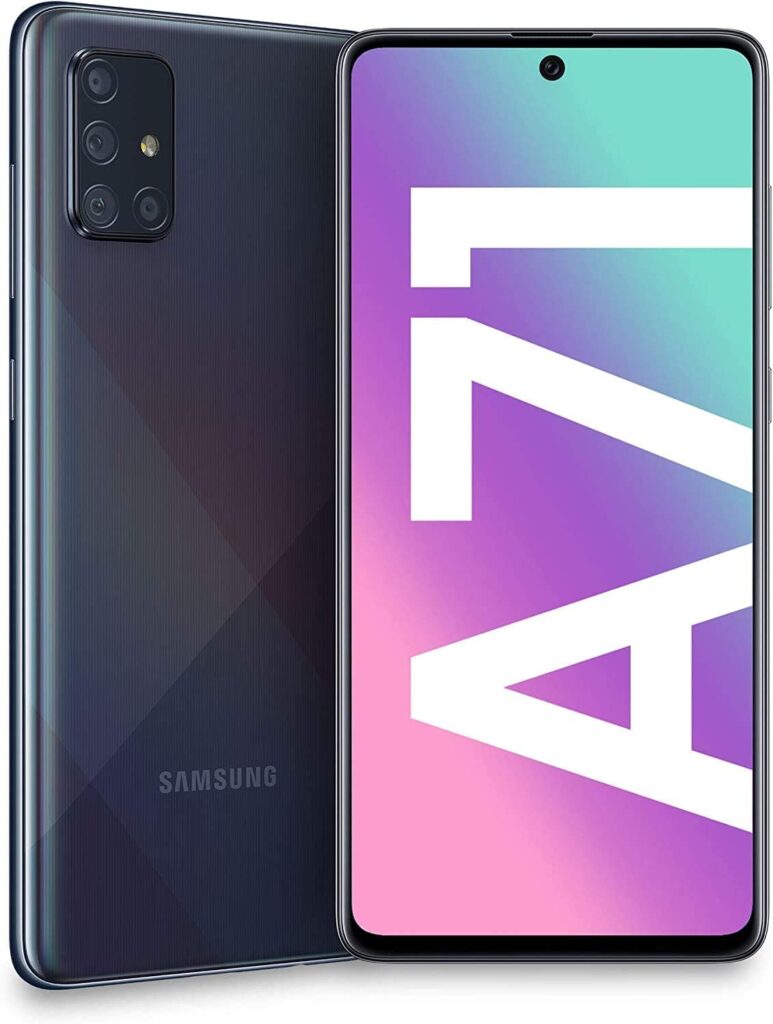Redmi Note 9 Pro (Xiaomi) and Galaxy A71 (Samsung) are midrange phones with similar specifications such as 6 GB RAM, 128 GB of storage, and a large battery. Xiaomi’s smartphone was announced in June 2020 and is available for $262, a value considered high for the company’s standards which are known for its cost-benefit.
The Galaxy A71 was announced at the beginning of the year and it’s also available for $385 depending on the offer of the day, but it is already cheaper than the launch price. Check below the differences in the specifications between the two devices.
Redmi Note 9 Pro vs Galaxy A71 Datasheet
| Redmi Note 9 Pro | Galaxy A71 | |
|---|---|---|
| Launch | June 2020 | January 2020 |
| Current price | $262 | $385 |
| Screen | 6.67 inches | 6.7 inches |
| Screen resolution | Full HD + (2400 x 1080 pixels) | Full HD + (2400 x 1080 pixels) |
| Processor | Snapdragon 720G | Snapdragon 730 |
| RAM | 6 GB | 6 GB |
| Storage | 128 GB | 128 GB |
| Memory card | yes, microSD up to 512 GB | yes, microSD up to 512 GB |
| Main camera | Quad camera: 64, 8, 5, and 2 megapixels | Quad camera: 64, 12, 5, and 5 MP |
| Front camera (selfie) | 16 MP | 32 MP |
| Operating system | Android 10 | Android 10 |
| Battery | 5,020 mAh | 4,500 mAh |
| Telephony | nano YES | nano YES |
| Dimensions and weight | 165.75 x 76.68 x 8.8 mm; 209 g | 163.6 x 76 x 7.7 mm; 179 g |
| Colors | gray, green, and white | blue, black, and silver |
Screen and Design

The size of the mobile phone screen is very similar. The Redmi Note 9 Pro has an IPS LCD of 6.67 inches and Full HD+ resolution (2400 x 1080 pixels), with a density of 395 PPI. The Galaxy A71 has a 6.7-inch panel with Full HD+ resolution (2400 x 1080 pixels) and Super AMOLED technology. The South Korean device features Gorilla Glass 3 protection against Redmi Note 9 Pro Gorilla Glass 5 protection.
The design of mobile phones is also similar. Both have thin edges and no notch. The front camera is housed in a hole in the screen, centralized at the top of the phone display. Another feature in common is the digital reader, which is integrated into the panel of both, allowing unlocking just by touching the screen. The two devices also have input for two chips.
While the Chinese smartphone is available in grey, green, and white, the Galaxy A71 can be purchased in blue, black, and silver finishes.
Camera

Redmi Note 9 Pro features a quad-camera consisting of a main 64 MP wide and f/1.9 aperture, an ultra-wide 8 MP lens and f/2.2 aperture, a 5 MP macro lens, and an f/2.4 aperture with autofocus, plus a 2 MP depth sensor and f/2.4 aperture. The photo set is capable of recording photos in RAW format, which allows for more accurate editing of the final image. The front camera is 16 MP.
The Galaxy A71 has a quad-camera with a 64 MP main sensor and f/1.8 aperture, 5 MP macro and f/2.4 aperture, but has superior quality in the ultra-wide lens, 12 MP and f/2.2 aperture, plus a depth sensor, 5 MP and f/2.2 aperture. The front camera records selfie up to 32 MP.
Both smartphones can record at 4K (2160p) on the rear camera at 30 frames per second, but only Galaxy A71 records at 4K on the front camera. Both smartphones have slow motion, digital stabilization, facial detection, and an HDR system, which assists in recording with more evident contrast.
Performance and Storage
The mobile phone technical file is very similar. The Galaxy A71 has a Snapdragon 730 octa-core processor at up to 2.2 GHz speed. Although the Redmi Note 9 Pro has a 2.3 GHz octa-core speed, the chipset is the Snapdragon 720G, which is focused on games and has a slightly less advanced architecture than the Samsung phone. Both work with the Adreno 618 GPU.
The RAM of both smartphones is 6 GB with 128 GB storage. Both have memory card capacity per microSD format up to 512 GB.
Battery
Both mobile phones have a big battery, but the Chinese smartphone has the advantage. The Galaxy A71 has a 4,500 mAh component and features a 25 W fast charge. The Redmi Note 9 Pro has a 5,020 mAh battery that can be recharged by a 30 W fast charger included in the box. With this, Xiaomi provides up to 16 hours of continuous browsing, 147 hours of music, and 13 hours of playing time.
Android version and Additional Features
The two phones leave the factory with Android 10, Google’s latest mobile system. Redmi Note 9 Pro also has a system integrated with the MIUI 11 interface while the Galaxy A71 received the latest version of the One UI.
Both feature Bluetooth 5.0, GPS, fingerprint sensor, and NFC. Regarding connectivity, both models connect to Wi-Fi in 802.11 a/b/g/n/ac bands. They also feature a compass and proximity sensor.
Price and Availability
Redmi Note 9 Pro arrived in the market for a price starting from $262.99 and can be found on Xiaomi’s official website and e-commerce websites like Amazon.
The Galaxy A71 arrived on the market in January of this year and, currently, it can be found for $385 in the colors black, blue, black, and silver.
This post may contain affiliate links, which means that I may receive a commission if you make a purchase using these links. As an Amazon Associate, I earn from qualifying purchases.

